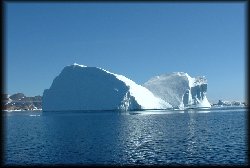 |
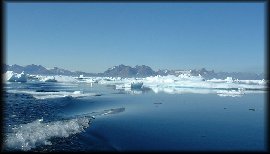 |
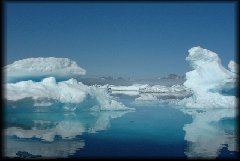 |
| Ice, ice, ice |
a short trip to Greenland and Iceland
Tan Wee Cheng, Singapore/London
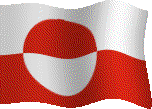 East
Greenland: The Seal Hunt
East
Greenland: The Seal Hunt
Sent:
05 August 2001
Kulusuk, East Greenland: I went on a seal hunt
I
became a Greenlandic seal hunter today, in what was one of my most extraordinary
travel experiences.
I
have barely arrived at Metteís home when her phone rang.
ďLook here, WeeCheng, thereís going to be seal hunt today.
If you are interested, you must set off now.Ē
I changed into the bulky outfit Mette gave me - multiple layers of thick
windbreaker, long johns and heavy boots that made me felt like a spaceman - and
then joined Benti on his weekend seal hunt.
Benti,
39, a native Inuit Greenlander whose youthful face doesnít betray many hours
spent in the cold biting winds of this harsh frontier land, works at Kulusukís
sole shop during the weekdays and hunt during the weekends, for vital seal meat
to feed the family as well his 15 dogs. Dog
sledge remains an important mode of transport in this remote part of Greenland
and the dogs must be well fed even in the summer months when dog sledges are
hardly used.
We
hopped onto Bentiís small two meter-long wooden boat, which Benti bought 10
years ago in Tasiilaq. The Inuits of today no longer hunt on kayaks, a local
invention that is now known worldwide, certainly one of the few Inuit words that
have entered the English language. Trees
are hardly indigenous in this treeless land and hence the boat was almost
certainly imported from Denmark, or at least the wood was. On it were three
rifles, a strange long stick with a hook at its end, and a long steel harpoon
somewhat worn out by age, laid out casually on the floor, plus a thermos flask
with coffee made half hour ago by Bentiís wife, a few plastic cups and two
packs of cookies Ė in case we stay out at sea for too long, says Benti.
A few orange-coloured safe jackets on the floor as well.
Benti smiled in a semi-defensive manner, my sons were with me this
morning, and they are young. Perhaps
he felt the need to apologise for the need to have safe jackets, which might
have diminished the symbolism of Inuit manhood.
We
sailed out of the harbour slowly, carefully negotiating the numerous icebergs
that have drifted into the sound between Kulusuk island and the Greenlandic
mainland. Here the mountains loomed
high in the background, haunting grayish silhouettes, and these, as well as
floating icebergs and onshore glaciers reflect light at every angle.
A graceful minke whale followed us while sea gulls circled us, hoping
that we would net some delicious catch and they might get some leftovers.
It was hard to believe merely 24 hours before, I was still sitting in my
London office, talking to other banks about bond issue and the risk of forex
fluctuations.
We
navigated among the zillions ice slabs and drifting ice.
No seals seen in the first hour plus or so.
Benti was getting impatient. Maybe his friends were wrong.
They have seen numerous seals coming with the southwards drifting ice.
A boat had netted seventeen for the day.
A few motorboats sped past us and Bent waved at his friends - most of
Kulusuk residents were going to the largest town of the district, Tasiilaq, for
the East Greenland Football Championships.
His wife had wanted him to sail her there.
No way, he had said, the dogs need to be fed.
Benti
scanned the ice and water. Seal,
seal, he shouted suddenly. Huh, nothing but icy waste for me all around.
Well, you have to trust an Inuit in his natural environment.
After all, this is a people with more than 30 words to describe ice.
Look at that moving black spot on the ice, he pointed at some point a
hundred meters ahead. We sailed
closer, and Benti turned off the engine. He
loaded rounds of Maxi Mag 22 WMR, bought at the Kulusuk supermarket (DKK 75 for
a 50 round-pack), into his rifle, a Magnum Marlin bought at the Tasiilaq market
for DKK 3000 (USD 400). He rested
the rifle on a handle, aimed at the black harp seal, and pressed the trigger.
Poom! Shit, he shouted. He missed,
and the seal turned. He aimed,
pressed the trigger and missed again. This
rifle needs zeroing, Benti shouted. He
needs to be quick, as the seal is now wiggling its way towards the water.
This time he hit the seal. It
jerked and was then still.
We sped towards the ice slab and there it was, bleeding profusely. Its warm blood had not only coloured its rich black coat red, but also melted a hole through the ice. The blood had flowed through and began to turn the seawater bloody tomato red. Benti raised his harpoon, and then thrust it through the sealís eyes, dealt with it a final blow. Only a courageous one can do that, for shooting per se is easy, an impersonal act. Thrusting the harpoon requires skill and judgement, for it needs to be done accurately so as not to damage the seal fur, and also promptly so as to shorten the sealís suffering. The Inuits believe in the environment, they believe that the seal, being an ancestor of man, gives its life so that man may live, and hence man, in return, must show compassion, and to kill with minimal suffering.
They
say the Inuits love the sealsí liver and other entrails fresh, and would
immediately cut these out for immediate raw consumption.
Benti was more concerned with getting the job done first and then rush
home to do some house repairs during the short weekends.
Using
a large hook stick, he dragged the seal into the water and then onto the boat,
although leaving the head sticking out over the water.
As our boat sped away, blood continued to spurt from the seal, leaving a
trail of blood in what was otherwise clear crystal blue waters of the Greenland
Sea.
The
fur would make a good coat, Benti says. This
seal is young and would taste nice in soup.
Older seals are normally left for the dogs.
The bones would go to the village artisans while the skin goes to the
government tannery. Times are bad. Animal rights campaigners in the West have destroyed the seal
skin market and prices have collapsed. The
Greenland Home Rule Government, through the Royal Greenland Company, has just
reduced the price of seals by half, to only DKK 250.
In reality it is worth only DKK 80, which is the price the government
sells to the few tanneries which have survived the world boycott against animal
skin. In other words, the
government effectively subsidises these subsistence hunters.
Beni says, my father is a great seal hunter, respected by everyone on the
island, and my mother used to spend all her time scaling and cleaning seal
skins. Now, with the low prices, they are better off just using the
skins for household use and collecting unemployment benefits from the Danish
welfare state.
Mind
you, this is not the big game hunter some of you despised.
Heís an average eastern Greenlander, 80% of whom are engaged in
subsistence hunting, hunting for survival, like their ancestors for thousands of
years. They hunt enough to feed
themselves and their dogs and never believe in taking more than they need.
Indeed, Benti is an environmentalist of sorts.
He placed the crisps wrapper and other rubbish at a corner of the boat,
rather than throw them overboard as people would have done elsewhere.
For
the Eastern Greenlandic Inuit who lives in a harsh land (85% covered by
permanent ice) with no agriculture and animal farming are possible, the hunting
of seals, which are not endangered animals, is one of their very few means of
subsistence survival. There are
more than 5 million seals in Greenland and 70,000 are taken every year.
Seal is a primarily source of meat for the Inuits and the fur, a
by-product. The selling of the skin to the Government provides some dignity and
spare cash for a people who would otherwise sit at home to receive unemployment
benefits that may help to send children to school, repairs for their houses (no,
they don't stay in igloos) and thick clothing for winter.
Seal skin export used to be the largest source of export income for
Greenland but this has collapsed since a US ban was imposed in 1972.
Unemployment is prevalent and I see many people sitting around without
anything to do. This has left the
Inuit people susceptible to alcoholism, domestic violence and suicide.
Alcohol consumption per capita is double that of Denmark, and suicides
and homicide account for an amazing 11% and 3% of all deaths respectively.
Suddenly,
Benti raised his rifle again. His
razor sharp eyes have spotted another seal, this time in the water.
The seal popped its head out of the water and then swam towards us.
Young one, Benti says, as they are inexperienced and not fearful of
mankind. Come to your death, he
says. This may sound distasteful but the Inuit are a straightforward people who
have little time for flowery language. Outsiders,
they say, speak too much, and shake the fragile world with bombastic words.
Pang! A few bubbles and then
the seal sank underneath. Shit,
Benti uttered. We sped to the spot.
Some blood on the surface but the seal had sank below.
Gone to the sharks, he says. If
you donít get the seal fast, they sometimes sink first and then you waste your
bullets.
As we
navigated in the fjord, suddenly Benti shouted, Look there!
Polar Bear! A gigantic
silhouette of a bear on an ice slab some distance away, looking as though it was
scanning the waters for live dinner. Benti
seemed to freeze for a few moments, and then relaxed, OK, itís just a natural
ice sculpture that looked like a polar bear.
We might be predators in the hunt for seals, but things are never
clear-cut with polar bears, a well-known man-eater.
Oneís instincts with polar bears might well be to escape from it,
although an Inuit may decide to take the risk and attempt to shoot it, for the
polar bearís beautiful fur, and to save the meat for special festivals and
events.
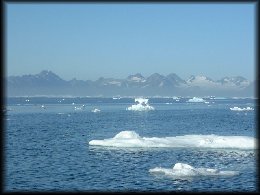 |
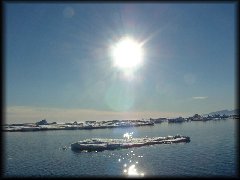 |
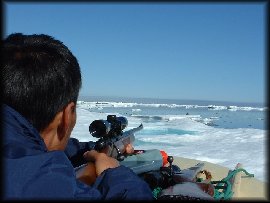 |
| Natural ice sculpture resembling a polar bear | Ice | Benti aiming at the seal... I could hardly see anything... |
We
continued the search for more seals. It
was getting exciting and I could hardly be bothered with the cold winds now.
And then we saw another moving object on a floating ice slab ahead.
Benti turned to me, hey friend, this is your chance to shoot the seal.
Itís no time for wishy washy urbanite thoughts.
The seal may look cute Ė an image created by Hollywood cartoonists.
Here I am with hunters who have it as a staple for thousands of years,
and Iím now offered the honor to participate in an ancient ritual.
I received the rifle - havenít touched ones since my army days Ė and
fitted it into my shoulder cave. The
ease betrayed some distant familiarity and a feel that came with a bit of
nostalgia. The seal was turning
itself on the icepack. I looked
through the bino, aimed again, held my breath, and then pressed the trigger
slowly. Pang! I jerked a
little. The smell of gunpowder in
the air. The seal was hit, and the
ice around it was slowly turning red with his spurting blood.
This was a magnificent Greenlandic seal, a great white coat with black
spots. Beautiful one, Benti says,
as he thrusted the harpoon into its eyes and ended its misery once and for all.
The
seal was too heavy for us to carry onto the boat.
We dragged it across a water puddle to the other side of the huge ice
slab, staining it red in the process. Be
careful, shouted Benti, for the ice may be thin.
A step into thin ice may mean certain death, or if one is lucky, a bad
douse in the icy waters, which is cold enough to be used by the Inuits as
natural refrigerator for raw meat. We
tied ropes on the ends of this enormous creature and then slowly dragged it back
to the boat, almost breaking our backs in the process. We laid it across the
front of the boat, skewing the boat slightly to the front.
We had to rearranged the other seal and other contents of the boat so as
to maintain a steady equilibrium in the water.
And
so we went on, and hunted a total of seven seals, including two shot by me.
By now, Bentiís friends had radioed him with the football results.
5 - 1, Tasiilaq had won. Not
to cry over, as Benti says. Believe
me, we people of Kusuluk would celebrate anyway despite the loss.
It
was getting dark as we decided to sail back to the village.
A lot more ice had in the meantime drifted into the sound, and we had
real difficulty navigating ourselves. Benti
was not deterred, ramming ice slabs which he deemed to be slow-drifters.
Iím naturally worried, for it looked as though he might sink the boat
any time. I shouldnít, for
Bentiís an experienced boatman as well. He
slowed down when he felt the ice was drifting too fast, and rammed at the slower
ones to open up a path for us.
The
temperature was dropping rapidly and I was getting sleepy too, having slept only
a few hours the night before. I
bent down to reduce my exposure to the howling wind, huddling against my
backpack and the safe jackets. No,
I shouldnít fall sleep. Thatís
dangerous in cold weather, as I remember how I nearly froze to death in the
mountains of Morocco. I decide to
sing to keep myself awake. You guys
know what a lousy singer I am, but nevertheless I sang the few pathetic songs I
knew. So, three songs - Majulah Singapura, my glorious national
anthem, Up the Mountains, a Chinese marching song, and Mary and her Little Lamb
- graced the icy winds of the Arctic, certainly with the most atrocious
mistuning and wrongfully inserted words, as I tried desperately battled the
cold. Alright, some of you may say
my songs might have actually led to further dropping in temperature. The lights of Kulusuk soon came into sight.
We passed the bright disco lights of the Community Hall.
Benti was right -
Kulusukís citizens would be celebrating despite the loss. With that, I look
forward to yet another exciting day in Greenland.
|
If you are open-minded and want to see graphic photos of the seal hunt,
|
Back to Greenland is Ice and Iceland is Green Homepage
Click here to send your comments to Tan Wee Cheng, Singapore
Click here to visit the author's homepage, Nomadic Tales